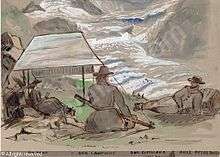Henry Acland


Sir Henry Wentworth Dyke Acland, 1st Baronet, KCB (23 August 1815 – 16 October 1900).[1] was an English physician and educator.
Life
Henry Acland was born in Killerton, Exeter, the fourth son of Sir Thomas Acland and Lydia Elizabeth Hoare, and educated at Harrow and at Christ Church, Oxford. He was elected Fellow of All Souls College, Oxford, in 1840, and then studied medicine in London and Edinburgh. Returning to Oxford, he was appointed Lee's reader in anatomy at Christ Church in 1845, was made a Fellow of the Royal Society in 1847,[2] and in 1851 Radcliffe librarian and physician to the Radcliffe Infirmary.[3]
Seven years later he became Regius Professor of Medicine, a post which he retained till 1894. He was also a curator of the university galleries and of the Bodleian Library, and from 1858 to 1887 he represented his university on the General Medical Council, of which he served as president from 1874 to 1887.
Acland was appointed a Companion of the Order of the Bath (CB) in 1883,[4] and was promoted to a Knight Commander (KCB) in 1884.[5] He was created a baronet in 1890,[6] and ten years later he died at his house in Broad Street, Oxford[3] (number 40 on the site of the new Bodleian Library building).
Acland took a leading part in the revival of the Oxford medical school and in introducing the study of natural science into the university. As Lee's reader he began to form a collection of anatomical and physiological preparations on the plan of John Hunter, and the establishment of the Oxford University Museum, opened in 1861, as a centre for the encouragement of the study of science, especially in relation to medicine, was largely due to his efforts. "To Henry Acland," said his lifelong friend, John Ruskin, "physiology was an entrusted gospel of which he was the solitary preacher to the heathen," but on the other hand his thorough classical training preserved science at Oxford from too abrupt a severance from the humanities. In conjunction with Dean Liddell, he revolutionised the study of art and archaeology, so that the cultivation of these subjects, for which, as Ruskin declared, no one at Oxford cared before that time, began to flourish in the university.[3]
Acland was also interested in questions of public health. He served on the Royal Commission on sanitary laws in England and Wales in 1869, and published a study of the outbreak of cholera at Oxford in 1854, together with various pamphlets on sanitary matters. His memoir on the topography of the Troad, with panoramic plan (1839), was among the fruits of a cruise which he made in the Mediterranean for the sake of his health.[3]
His son, Colonel Alfred Dyke Acland married Hon. Beatrice Danvers Smith, daughter of Rt. Hon. W. H. Smith of the Newsagents dynasty on 30 July 1885 and gained the rank of Lieutenant-Colonel in 1910 in the service of the Royal 1st Devon Yeomanry (Territorial Army). Another son, Theodore Dyke Acland married the daughter of Sir William Gull, a leading London medical practitioner and one of the Physicians-in-Ordinary to HM Queen Victoria.
Marriage and children

He married Sarah Cotton, daughter of William Cotton and Sarah Lane, on 14 July 1846. They had seven sons and a daughter:
- Admiral Sir William Alison Dyke Acland, 2nd Baronet (1847–1924)
- Sarah Angelina Acland (1849–1930)
- Henry Dyke Acland (1850–1936)
- Theodore Dyke Acland (1851–1931), the father of Theodore Acland (1890–1960)
- Herbert Dyke Acland (1855–1877)
- Sir Reginald Brodie Dyke Acland (1856–1924)
- Francis Edward Dyke Acland (1857–1943)
- Alfred Dyke Acland (1858–1937)
The old Acland Hospital, initially in Wellington Square, Oxford and later on the Banbury Road in Oxford (now part of Keble College), was founded in memory of Acland's wife, Sarah.
Their daughter, Sarah Acland, subsequently lived in Park Town and was an early pioneer of colour photography. Some of her photographs are in collection of the Museum of the History of Science in Broad Street, opposite the family home.[7]
References
- ↑ Chambers Biographical Dictionary, ISBN 0-550-18022-2, p. 6
- ↑ List of Fellows of the Royal Society, A – J. royalsociety.org
- 1 2 3 4
 One or more of the preceding sentences incorporates text from a publication now in the public domain: Chisholm, Hugh, ed. (1911). "Acland, Sir Henry Wentworth, Bart.". Encyclopædia Britannica. 1 (11th ed.). Cambridge University Press. p. 149.
One or more of the preceding sentences incorporates text from a publication now in the public domain: Chisholm, Hugh, ed. (1911). "Acland, Sir Henry Wentworth, Bart.". Encyclopædia Britannica. 1 (11th ed.). Cambridge University Press. p. 149. - ↑ The London Gazette: no. 25278. p. 4918. 16 October 1883.
- ↑ The London Gazette: (Supplement) no. 25358. p. 2331. 24 May 1884.
- ↑ The London Gazette: no. 26061. p. 3297. 13 June 1890.
- ↑ "Sarah Acland Results List". Oxford: Museum of the History of Science. Retrieved 16 January 2013.
External links
| Wikimedia Commons has media related to Henry Acland. |
- "Archival material relating to Henry Acland". UK National Archives.
- Gardner's 1852 Directory for the City of Oxford entry
 Power, D'Arcy (1901). "Acland, Henry Wentworth". In Sidney Lee. Dictionary of National Biography, 1901 supplement. London: Smith, Elder & Co.
Power, D'Arcy (1901). "Acland, Henry Wentworth". In Sidney Lee. Dictionary of National Biography, 1901 supplement. London: Smith, Elder & Co. - Fox, Robert. "Acland, Sir Henry Wentworth, first baronet (1815–1900)". Oxford Dictionary of National Biography (online ed.). Oxford University Press. doi:10.1093/ref:odnb/62. (Subscription or UK public library membership required.)
| Baronetage of the United Kingdom | ||
|---|---|---|
| Preceded by New creation |
Baronet (of St Mary Magdalen) 1890–1900 |
Succeeded by William Dyke Acland |
